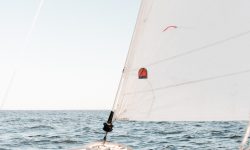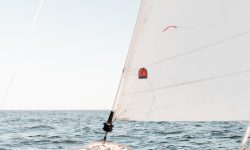Welcome to our blog post on the art of sailing, where we will explore the essential elements that every sailor must understand and master. In this post, we will delve into the power of wind, its significance for sailors, and how to harness and control it effectively. We will also explore the crucial aspect of navigating tides, understanding their impact on sailing, and utilizing currents for efficient navigation. Join us as we unravel the secrets of mastering the art of sailing by harmonizing with the forces of wind, tides, and currents.
The Wind: A Sailor’s Essential Element
The wind is an essential element for any sailor, as it provides the power needed to propel a boat through the water. Understanding the wind is a fundamental skill that every sailor must possess in order to navigate effectively and safely.
When sailing, it is important to be aware of the different types of wind and how they can affect your course. There are three main types of wind: headwind, tailwind, and crosswind. A headwind blows directly towards the bow of the boat, making it more difficult to sail against. On the other hand, a tailwind blows directly from behind and can provide a powerful push, increasing the boat’s speed. A crosswind blows across the boat’s path, requiring the sailor to adjust the sails and the boat’s angle accordingly.
One of the key skills in sailing is harnessing and controlling the power of the wind. The ability to trim the sails allows sailors to maximize the power generated by the wind. Understanding how to adjust the sails’ angle and tension can help optimize the boat’s speed and efficiency. When the wind is strong, it is important to reef the sails to reduce their size and avoid overpowering the boat. Conversely, when the wind is light, it is crucial to maximize the surface area of the sails to catch as much wind as possible.
| Type of Wind | Effect on Sailing |
|---|---|
| Headwind | Increases difficulty, requires tacking or beating |
| Tailwind | Provides a powerful push, increases speed |
| Crosswind | Requires adjusting sails and boat’s angle |
Another important aspect of understanding the wind is being able to read and interpret the wind indicators. These can include wind vanes, flags, and the movement of the water’s surface. By observing these indicators, sailors can anticipate changes in wind direction and adjust their sailing strategy accordingly.
The wind also plays a crucial role in determining the best course to take when sailing. Sailors must consider the direction and strength of the wind when planning their route. By utilizing the wind effectively, sailors can sail efficiently and reach their destination more quickly.
In conclusion, the wind is indeed a sailor’s essential element. By understanding the different types of wind, harnessing its power, and utilizing it effectively, sailors can navigate the waters with confidence and skill. The art of sailing is intricately intertwined with the wind, and mastering its complexities is key to becoming a skilled sailor.
Harnessing And Controlling The Power Of Wind
Sailing is an ancient art that has been practiced for centuries, relying on the power of the wind to propel vessels across the vast expanse of the ocean. The wind, with its invisible force, is a sailor’s essential element, and understanding how to harness and control its power is crucial for a successful voyage.
The first step in harnessing the power of the wind is understanding its behavior and characteristics. Wind is created by the movement of air masses from areas of high pressure to areas of low pressure. As a result, it is influenced by various factors such as temperature, atmospheric pressure, and the Earth’s rotation.
Once you have a grasp of the wind’s nature, it is important to know how to use different sailing techniques to control the vessel’s speed and direction. One such technique is adjusting the sails to catch the wind efficiently. By manipulating the angle and position of the sails, sailors can maximize the force exerted by the wind and propel the boat forward.
Navigating Tides: A Crucial Aspect Of Sailing
The Art of Sailing: Understanding Wind, Tides, and Currents is a multidimensional skill that requires a thorough knowledge of various factors. Among these, tides play a crucial role in the success and safety of any sailing venture. Tides are the rise and fall of sea levels caused by the gravitational forces exerted by the moon and the sun. In this blog post, we will delve into the significance of tides in sailing and explore how sailors can navigate through them effectively.
Tides have a significant impact on the navigation of a sailboat. Understanding the behavior of tides is paramount for sailors in terms of both safety and efficiency. Tides influence the depth of water, and as a result, affect the accessibility of certain areas. It is vital for sailors to be aware of the tidal range, which is the difference between high tide and low tide, as it will determine the draft of their vessel and the routes they can take.
Furthermore, tides have a significant impact on the water flow, creating currents that can either assist or impede sailing. When sailing with the current, sailors experience enhanced speed and maneuverability, allowing them to cover larger distances in a shorter amount of time. Conversely, sailing against the current can be a challenging task, requiring more effort and consuming additional fuel or energy.
Tidal Phases Description High Tide Occurs when the water level is at its highest point during a tide cycle. It provides access to shallow areas that are usually inaccessible. Low Tide Occurs when the water level is at its lowest point during a tide cycle. It can reveal hazards such as rocks or sandbanks that are usually submerged. Flood Tide Occurs when the tide is rising, and water is flowing into harbors, rivers, or other coastal areas. Sailing with the flood tide can enhance speed and navigational possibilities. Ebb Tide Occurs when the tide is receding, and water is flowing out of harbors, rivers, or other coastal areas. Sailing against the ebb tide can present challenges and require additional effort.
Sailing with the tides requires proper planning and timing. Sailors need to be aware of the tidal charts, which provide information on the times and heights of tides. By studying these charts, sailors can determine the best times to set sail or enter/exit certain areas. Tides can also have a significant impact on anchoring, as the depth and strength of the current will affect the stability of the boat.
In conclusion, understanding tides is an essential aspect of sailing. By comprehending the behavior and phases of tides, sailors can make informed decisions to ensure safe and efficient voyages. Navigating tides requires careful planning, taking into account tidal ranges, flow directions, and tidal charts. By harnessing the power of tides, sailors can navigate through various water bodies with ease and experience the thrill of mastering this crucial aspect of sailing.
Utilizing Currents For Efficient Sailing
Sailing is an art that requires a deep understanding of the elements that govern the open waters. Among these elements, wind, tides, and currents play a crucial role in ensuring a smooth and efficient sailing experience. When it comes to utilizing currents for efficient sailing, sailors must possess a thorough knowledge of how these natural forces interact with their vessel. By harnessing the power of currents, sailors can enhance their speed, maneuverability, and overall efficiency on the water.
Currents are the continuous, flowing movements of water caused by a variety of factors such as wind patterns, tidal changes, and even the shape of the coastline. To effectively utilize currents for sailing, sailors must first study and analyze the patterns of the currents in their desired sailing area. By understanding the direction, speed, and strength of the currents, sailors can strategically plan their routes and take advantage of the natural flow of water.
One of the key benefits of utilizing currents for sailing is the potential to increase speed without relying solely on wind power. When sailing with a favorable current, the boat can be propelled forward even with minimal wind, or even in the absence of wind altogether. This is particularly advantageous in areas where the wind conditions may be unpredictable or inconsistent. By leveraging the power of currents, sailors can maintain a steady pace and make efficient progress towards their destination.
Type of Current Description Transitional Current Flows between periods of tidal changes Tidal Current Caused by the gravitational forces of the moon and sun Wind-Driven Current Result of wind pushing surface water
In addition to increasing speed, utilizing currents can also enhance a sailor’s maneuverability. By skillfully positioning their vessel in relation to the currents, sailors can effectively control their trajectory. By sailing with the current, sailors can reduce the effort required to navigate, making it easier to steer and change direction. This not only enhances efficiency but also provides sailors with more control and precision in their movements on the water.
It’s important to note that mastering the art of utilizing currents for efficient sailing requires constant observation and adaptation. Currents can change dynamically, influenced by factors such as tidal cycles, weather patterns, and seasonal variations. Therefore, sailors must continuously monitor and adjust their course accordingly, making the necessary changes to optimize their sailing performance.
In conclusion, understanding and utilizing currents for efficient sailing is a skill that can greatly enhance a sailor’s experience on the water. By studying the patterns, leveraging the speed, and harnessing the maneuverability provided by currents, sailors can navigate their vessels with precision and efficiency. So, next time you set sail, don’t overlook the power of currents – they may just be the key to unlocking a truly remarkable sailing adventure.
Mastering The Art Of Sailing: Wind, Tides, And Currents
Mastering The Art Of Sailing: Wind, Tides, And Currents
Sailing is a captivating sport that requires both skill and knowledge of the elements. Among these elements, wind, tides, and currents play a crucial role in determining a sailor’s success. Understanding and harnessing these forces is essential for mastering the art of sailing. In this blog post, we will delve into the intricacies of wind, tides, and currents, exploring how they influence a sailor’s navigation and providing insights into how to effectively utilize them.
The Wind: A Sailor’s Essential Element
The wind, without a doubt, is the most crucial factor for achieving a successful sail. It is the driving force that propels the boat forward, allowing it to maneuver through the water. As a sailor, it is imperative to comprehend the intricacies of wind patterns, such as direction, speed, and gusts. The direction of the wind determines the course a sailor can take, while its speed affects the boat’s pace. Furthermore, understanding gusts, sudden bursts of wind, is vital for adjusting the sail and maintaining stability.
Navigating Tides: A Crucial Aspect Of Sailing
Tides are another key component that sailors must consider when planning their routes. Tides are the periodic rise and fall of sea levels caused by the gravitational forces of the moon and the sun. They have a significant impact on water depth, the strength of currents, and the obstruction of navigational routes. By understanding the tide tables and consulting nautical charts, sailors can optimize their routes to take advantage of favorable tides, ensuring efficient and safe journeys.
Utilizing Currents For Efficient Sailing
Currents are the continuous, horizontal movements of water that are driven by factors such as temperature, salinity, and tidal forces. They can either aid or impede a sailor’s progress, depending on how they are utilized. By studying current charts, sailors can identify favorable currents to gain additional speed and conserve energy. Through strategic use of currents, sailors can navigate around obstacles, plan shorter routes, and minimize the time spent on the water.
Element Key Considerations Wind Direction, speed, gusts Tides Water depth, strength of currents, navigational routes Currents Temperature, salinity, tidal forces
Mastering the art of sailing entails a deep understanding of wind, tides, and currents. These elements are intertwined, and their interplay can greatly influence the outcome of a sail. By continually learning and honing their skills, sailors can navigate the seas with confidence, harnessing the power of wind, tides, and currents to become masters of their craft.
Frequently Asked Questions
What role does wind play in sailing?
Wind is an essential element in sailing as it provides the primary source of power to propel the sailboat forward.
How can sailors harness and control the power of wind?
Sailors can harness the power of wind by adjusting the sails and using various sailing techniques to sail in different wind conditions. They can also control the direction and speed of the boat by trimming the sails.
Why is navigating tides crucial in sailing?
Navigating tides is crucial in sailing because tides can affect the depth of water, currents, and the overall speed and direction of the boat. Sailors need to take into account the tidal patterns to plan their routes and avoid obstacles.
How can sailors utilize currents for efficient sailing?
Sailors can utilize currents by strategically planning their route to take advantage of favorable currents that can provide a boost in speed. They can also use currents to determine the best time to sail in certain areas.
What are the key factors to master the art of sailing?
To master the art of sailing, one needs to understand and effectively utilize the elements of wind, tides, and currents. This includes understanding how they interact with each other and how to adjust sail and navigate accordingly.
What are some sailing techniques to effectively use wind, tides, and currents?
Some sailing techniques to effectively use wind, tides, and currents include tacking and jibing to sail against or with the wind, using the tidal flow to gain an advantage, and adjusting the sails to minimize the impact of currents.
How can sailors optimize their sailing performance through wind, tides, and currents?
Sailors can optimize their sailing performance by continually observing and analyzing the wind, tides, and currents. They can make adjustments to their sailing techniques and routes to optimize their speed, efficiency, and overall sailing experience.




